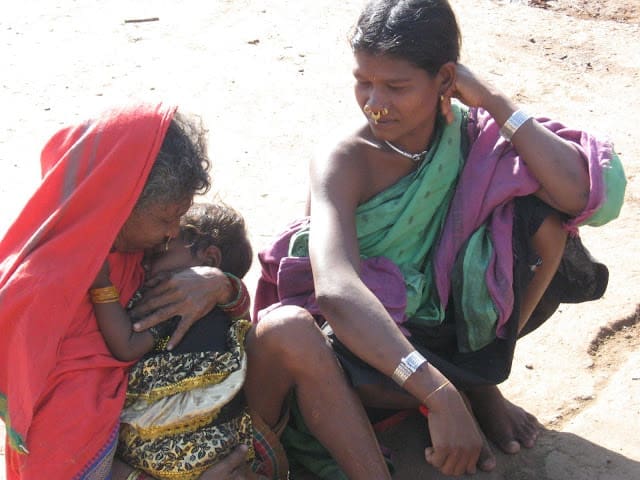En route to Chhattisgarh’s tribal heartland, Jennifer Nandi is overwhelmed by the dignified social intelligence of Odisha’s Kondha and Paraja tribes
We are on the road by 8 am travelling to Jeypore. Spectacular scenery on both sides of a run-down highway leaves us mesmerised. Lush and green, Odisha looks so rich. Sadly the state is battling grinding poverty. We stop at a village of Niyamgiri where we interact with the Kondha tribes who were once infamous for human sacrifice. Their native language called “Kui” has no written script. Some anthropologists refer to these tribals as being part of a Proto-Australoid group. Certainly the older women do indeed bear a passing physical resemblance to Australian aborigines. The younger women are lithe and beautiful with tattoo markings and jewellery and a piece of cloth wound around the waist and then carelessly thrown over the shoulders. I am amazed at such natural beauty worn so easily. They sit in the warm sunlight, looking at us take pictures, talking to their babies, bathing their little ones, pounding rice, just carrying on despite our nosiness, our inelegant clothes and ungainliness with our shiny cameras. The group embodies an intelligence that seems to be fundamentally social.
 |
| Kondha tribal women |
With a culture intricately interwoven with the forest environment, the natural wisdom of these land-dwellers is under threat. Surrounding their village is thick forest that hides the bauxite that the Indian Government wants to mine. The villagers have refused to move. For how long can they keep their ground? Media writing will diminish their stories, undermine their character and trivialize their concerns. Slowly though, their assimilation into mainstream India will take place. For now, they receive quantities of food because they are considered below the poverty line; toilets are built for them and some arrangement for schooling of the young is made. We drive away with mixed feelings for a people who belong to a different time.
 |
| What’s he smoking? |
Further down the winding road we halt to greet a man smoking a huge cigar. He hails from another village but is from the same Kondha tribe. We ask permission to photograph him and he gladly poses for the camera. I’m very interested in the leaves of the cigar so, with much nodding and gesturing and a big smile to ameliorate my language shortcoming, I learn that they come from the Tendu tree – the same tree with whose leaves beedis are made.
Verdant vistas unveil as we hurtle forward on yet another hairpin bend of the Eastern Ghats. But all is not well. The green equilibrium is punctuated by a strong military and Central Reserve Police Force presence.
In fact, until the hills drop away and the land levels into the plains of Jeypore, we are continually reminded that we are pushing the envelope of unknowns here. Sadly, the forests of Orissa that spill over into the state of Chattisgarh provide a haven for Naxalites. Yet the Naxalites are firmly on the side of the tribals. Who fought for Australia’s aborigines when mining magnates sold their entire country’s mineral wealth to the Chinese?
Anyway the welter of questions without answers doesn’t stop us from birding! Where sections of the forest yield to coffee plantations, we stop to have a quick look round.There are Ultramarine Flycatchers, White-browed Bulbuls and Black-winged Cuckoo-shrikes – the last of these I think are at the very edge of their distribution. There are other calls and I’m torn between spending more time here and heading off to our destination. To explore with undying curiosity is so empowering – I often wish more parents would spend time just nurturing this one quality in their children. My decision is made for me – our guide Tapan gently stands close to us and smiles. It’s time to go! But we negotiate to come back to this place tomorrow before we journey on to visit other tribal villages.

The Hotel Hellow in Jeypore is unattractive but the food is very good – after a hurried lunch we dash off to more villages. The Paraja tribes of Nandpur village are agriculturalists, Tapan tells us, shifting their nomadic settlements in the face of natural calamities. Yet their homes seem more substantial than those of the Kondha.

Grain is spread out in the sun to dry. It appears to be of the millet family – so named for those thousands of grains harvested from a single seed grown. I’m guessing it’s finger millet – Orissa being one of the important finger millet growing states. Although the grain’s ‘centre of diversity’ is probably in the Ethiopian highlands, it was introduced into India more than 3,000 years ago. But, as is the fate of all our grains, Ragi, as it is known in this part of the subcontinent, has many hybrid varieties developed by crossing Indian and African cultivars. I’m not so sure these hybrids compare well with the traditional varieties. For one thing, the stem of the hybrids has very low fodder value and for another, they would have to be grown in pure stands. The mixed cropped fields of the Deccan area is no place for hybrids. But in the hybrid stands I wouldn’t be surprised that the wild species Eleusine indica and E. aegyptiaca grow as weeds. I have learned that the wild grains are smaller and well enclosed in the ‘glumes’ which is a word from Latin meaning ‘hull’ or ‘husk’. Anyway, for taste, I’d choose the traditional. It comes at a higher price, so we learned at the local village market.
Text and photos by Jennifer Nandi


